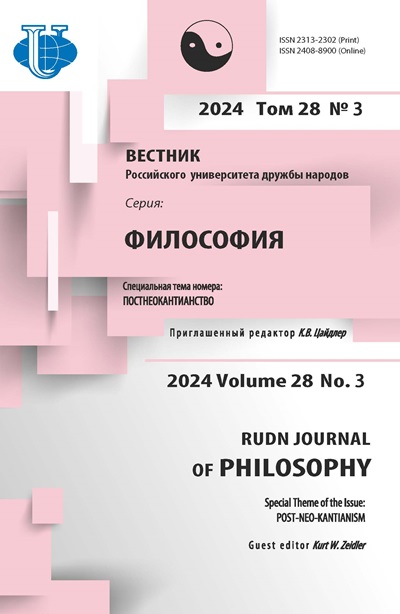Дискуссия о субъекте в «Милиндапаньхе»: новый перевод и комментарии
- Авторы: Титлин Л.И.1
-
Учреждения:
- Институт философии РАН
- Выпуск: Том 25, № 2 (2021): ИСТОРИЧЕСКИЕ ТРАДИЦИИ И СОВРЕМЕННАЯ ФИЛОСОФИЯ ВОСТОКА
- Страницы: 260-275
- Раздел: ИСТОРИЧЕСКИЕ ТРАДИЦИИ И СОВРЕМЕННАЯ ФИЛОСОФИЯ ВОСТОКА
- URL: https://journals.rudn.ru/philosophy/article/view/26669
- DOI: https://doi.org/10.22363/2313-2302-2021-25-2-260-275
Цитировать
Полный текст
Аннотация
Приводится новый перевод на английский язык отрывков из «Милиндапаньхи» о субъекте и авторские комментарии к ним. Перевод предваряется кратким изложением произведения (по книгам и главам) и сведениями о существующих переводах на европейские языки. Автор полемизирует с такими представителями современной философии, как Сидеритс и приходит к выводу, что на самом деле Сидеритс является, скорее, не редукционистом, а эмерджентистом, или сторонником теории систем, что подтверждается его апелляцией к переводимым отрывкам из «Милиндапаньхи», которые автор предлагает рассматривать в ключе теории систем и утверждает, что ранний буддизм, как он дан нам, в частности, в рассматриваемом тексте, скорее склоняется не редукционизму и простому отрицанию «я» или «субъекта», но к мягкому варианту теории эмерджентизма. Автор выражает свое несогласие с «семиотической трактовкой» вопроса А. Парибка и в качестве подтверждения своей онтологическо-гносеологической трактовки отсылает к таким текстам, как «Катхаваттху», «Ваджира-сутта» и «Пудгала-винишчая» Васубандху. В конце статьи делается вывод, что если ранний буддизм (то есть еще как минимум в I в. н.э., в «Милиндапаньхе») в отношении субъекта придерживался, скорее, теории систем и эмерджентизма (нередукционизма), то к IV в. (Васубандху «Абхидхармакоша») происходит уже существенный сдвиг в сторону аннигиляционизма (редукционизма) и субъект («я») начинает уже напрямую отрицаться в научных трактатах.
Ключевые слова
Об авторах
Лев Игоревич Титлин
Институт философии РАН
Автор, ответственный за переписку.
Email: titlus@gmail.com
кандидат философских наук, старший научный сотрудник, сектор восточных философий
Российская Федерация, 109240, Москва, ул. Гончарная, 12/1Список литературы
- Siderits M. Personal Identity and Buddhist Philosophy. Aldershot, England: Ashgate; 2003.
- Trenckner V, editor. The Milindapañho: Being Dialogues Between King Milinda and the Buddhist Sage Nāgasena. London: Williams and Norgate; 1880.
- Rhys Davids TW, translator. The Questions of King Milinda. Oxford: The Clarendon Press; 1890, 1894.
- Horner IB, translator. Milinda's Questions. London: Wisdom Publications; 1963-1964.
- Pesala В, translator. The Debate of King Milinda [Internet]. Penang: Inward Path; 2001 [cited 2021 Apr 27]. Available from: http://www.buddhanet.net/pdf_file/ milinda.pdf
- Paribok AV, translator. The Questions of Milinda (the Milindapañho). M.: Nauka; 1989. (In Russian).
- Nyanatiloka T, translator. Die Fragen des Milindo. Bd. 1. Leipzig; 1919. Bd. 2. Munchen-Neubiberg; 1924.
- Finot L, translator. Milinda-Pañha. Les questions de Milinda. Paris: Bossard; 1923.
- Nolot É, translator. Entretiens de Milinda et Nāgasena: Version intégrale. Paris: Gallimard; 1995.
- Potter KH, editor. Encyclopedia of Indian Philosophies. Vol. VII. Abhidharma Buddhism to 150 A.D. Delhi: Motilal Banarsidass; 2006.
- Titlin LI. The Polemics Between the Buddhists and the Vaisheshikas on the Self in “Pudgalavinishchaya” of Vasubandhu. RUDN Journal of Philosophy. 2019;23(1):46-55.
- Gopnik A. Could David Hume Have Known about Buddhism?: Charles François Dolu, the Royal College of La Flèche, and the Global Jesuit Intellectual Network. Hume Studies. 2009;35(1):5-28.
- Giles J. The no-Self Theory: Hume, Buddhism, and Personal Identity. Philosophy East and West. 1993;43(2):75-200.
- Taylor AC, editor. Kathāvatthu. In 2 Vols. London: Pali Text Society; 1984.
- Kapstein M. Reason's Traces: Identity and Interpretation in Indian and Tibetan Buddhist Thought. Boston: Wisdom Publications; 2001.
- Titlin LI. The Concept of Pugdala in the Buddhist School of Pudgalavāda: the Problem of Interpretation and the Evolution of the Conception. RUDN Journal of Philosophy. 2014;1:105-111.
- Rosenberg OO. Problems of Buddhist Philosophy. In: Rosenberg OO. Works on Buddhism. Moscow: Nauka; 1991.
- Rhys Davids TW, Stede W, editors. The Pali Text Society's Pali-English dictionary. London: Chipstead; 1921-1925.
- Kant I. Works in German and Russian. Critique of Pure Reason. Vol. 2. Part 1. Moscow: Nauka; 2006. (In Russian).
- Shastri SD, editor. Abhidharmakosa & Bhasya of Acharya Vasubandhu with Sphutartha Commentary of Acharya Yasomitra. Part II. Varanasi: Bauddha Bharati; 1970.
- Titlin LI. Vasubandhu. Abhidharmakośa, Book 9 “Pudgalaviniścaya” With the Commentary “Spuṭārtha” of Yaśomitra. Translation from Sanskrit, Introduction, Investigation and Comments by Lev Titlin. Moscow: Buddadharma; 2021. (In Russian).
















